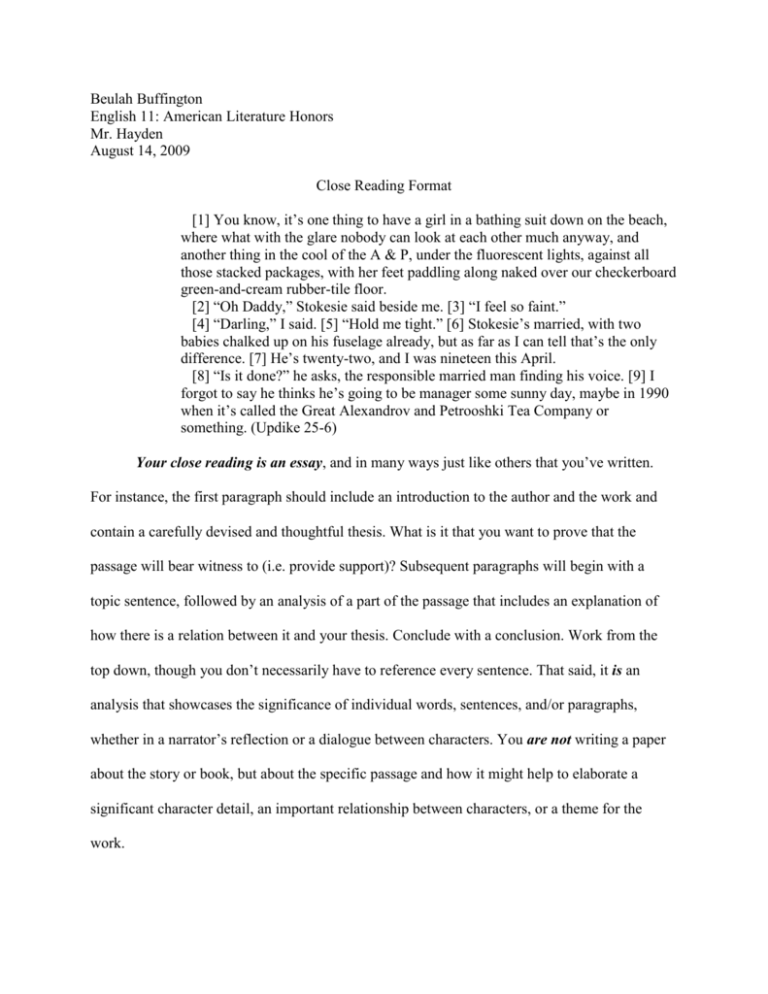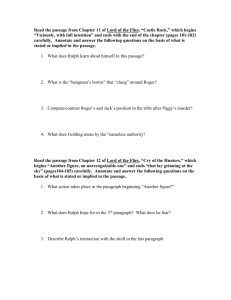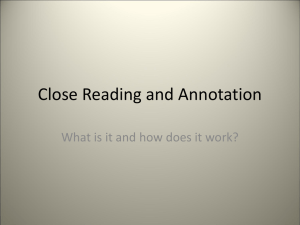Nuns fret not at their convent`s narrow room
advertisement

Beulah Buffington English 11: American Literature Honors Mr. Hayden August 14, 2009 Close Reading Format [1] You know, it’s one thing to have a girl in a bathing suit down on the beach, where what with the glare nobody can look at each other much anyway, and another thing in the cool of the A & P, under the fluorescent lights, against all those stacked packages, with her feet paddling along naked over our checkerboard green-and-cream rubber-tile floor. [2] “Oh Daddy,” Stokesie said beside me. [3] “I feel so faint.” [4] “Darling,” I said. [5] “Hold me tight.” [6] Stokesie’s married, with two babies chalked up on his fuselage already, but as far as I can tell that’s the only difference. [7] He’s twenty-two, and I was nineteen this April. [8] “Is it done?” he asks, the responsible married man finding his voice. [9] I forgot to say he thinks he’s going to be manager some sunny day, maybe in 1990 when it’s called the Great Alexandrov and Petrooshki Tea Company or something. (Updike 25-6) Your close reading is an essay, and in many ways just like others that you’ve written. For instance, the first paragraph should include an introduction to the author and the work and contain a carefully devised and thoughtful thesis. What is it that you want to prove that the passage will bear witness to (i.e. provide support)? Subsequent paragraphs will begin with a topic sentence, followed by an analysis of a part of the passage that includes an explanation of how there is a relation between it and your thesis. Conclude with a conclusion. Work from the top down, though you don’t necessarily have to reference every sentence. That said, it is an analysis that showcases the significance of individual words, sentences, and/or paragraphs, whether in a narrator’s reflection or a dialogue between characters. You are not writing a paper about the story or book, but about the specific passage and how it might help to elaborate a significant character detail, an important relationship between characters, or a theme for the work. Buffington 2 Formatting: follow your title (not Close Reading Format, but rather something that indicates what your close reading proposes. Ex. Male Attitudes in John Updike’s “A&P”) with the passage from the book, story, or poem. The passage is typed out, single-spaced, in the same format in which it is found in the original source, keeping paragraph breaks and indents. Notice that quotation marks are only used where they are found in the original (no need to put quotations around the entire passage). The whole thing is indented 1”, and each new paragraph gets indented three spaces from there. Each sentence is numbered as shown above, and this is the method by which you reference your analysis of the passage. In other words, you analyze the passage at the sentence level and refer to them individually. For example, your analysis of sentence one might begin, “In sentence one…” Or, in talking about sentence eight, you might say, “The reference to ‘the Great Alexandrov and Petrooshki Tea Company’ provides a Cold War context for Updike’s story [8],” using the bracketed eight at the end like an MLA page citation. Remember that because this is a close reading, the passage needs to be of a manageable length. However, if a narrative or conversation takes place over a page or two, you can eliminate “filler” by using a bracketed ellipsis to show that you’ve made a cut: [1] At last I had an idea; and I says, I'll go and write the letter -- and then see if I can pray. [2] Why, it was astonishing, the way I felt as light as a feather right straight off, and my troubles all gone. […]. [3] It was a close place. [4] I took it up, and held it in my hand. I was a-trembling, because I'd got to decide, forever, betwixt two things, and I knowed it. [5] I studied a minute, sort of holding my breath, and then says to myself: [6] “All right, then, I'll GO to hell” -- and tore it up. (Twain 191-2) Buffington 3 The […]. between the first two paragraphs shows that an entire paragraph has been omitted. The bracketed ellipsis can also be used in the middle of sentences to cut out insignificant phrases, or in the middle of paragraphs to cut out insignificant sentences. The last thing you need to do is to provide a works cited for your paper, and this would be the standard works cited for all types of papers. There are no special instructions.








